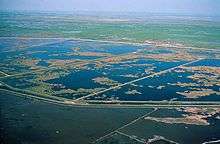Kesterson National Wildlife Refuge

The Kesterson National Wildlife Refuge was an artificial wetland environment, created using agricultural runoff from farmland in California's Central Valley.
The irrigation water is transported to the valley from sources in the Sierra Nevada via the California Aqueduct. Minerals from these sources are carried in the water and concentrated by evaporation from aqueducts, canals, and fields. This has resulted in an exceptionally high accumulation of selenium and other minerals in the wetlands. Wildlife in this region suffered deformities[1] due to selenium poisoning, drawing the attention of news media and leading to the closure of the refuge.[2][3]
Kesterson Reservoir was a unit of the refuge but is now part of San Luis National Wildlife Refuge.
See also
References
- ↑ https://web.archive.org/web/20041029064607/http://minerals.cr.usgs.gov/gips/ducklrg.gif. Archived from the original on October 29, 2004. Retrieved February 15, 2005. Missing or empty
|title=(help) - ↑ https://web.archive.org/web/20050310041621/http://minerals.cr.usgs.gov/gips/0elemap.htm. Archived from the original on March 10, 2005. Retrieved February 15, 2005. Missing or empty
|title=(help) - ↑ "Tragedy at Kesterson Reservoir: Death of a Wildlife Refuge Illustrates Failings of Water Law". Environmental Law Reporter. 1985. Retrieved 12 June 2016.
External links
Coordinates: 37°15′30″N 120°53′34″W / 37.25833°N 120.89278°W